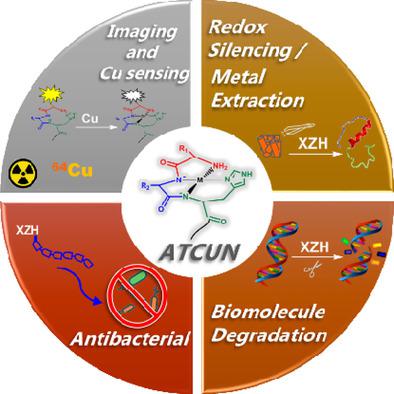当前位置:
X-MOL 学术
›
Chem. Eur. J.
›
论文详情
Our official English website, www.x-mol.net, welcomes your feedback! (Note: you will need to create a separate account there.)
N‐Terminal Cu‐Binding Motifs (Xxx‐Zzz‐His, Xxx‐His) and Their Derivatives: Chemistry, Biology and Medicinal Applications
Chemistry - A European Journal ( IF 4.3 ) Pub Date : 2018-03-24 , DOI: 10.1002/chem.201705398 Paulina Gonzalez 1, 2 , Karolina Bossak 3 , Ewelina Stefaniak 3 , Christelle Hureau 2, 4 , Laurent Raibaut 1 , Wojciech Bal 3 , Peter Faller 1, 2
Chemistry - A European Journal ( IF 4.3 ) Pub Date : 2018-03-24 , DOI: 10.1002/chem.201705398 Paulina Gonzalez 1, 2 , Karolina Bossak 3 , Ewelina Stefaniak 3 , Christelle Hureau 2, 4 , Laurent Raibaut 1 , Wojciech Bal 3 , Peter Faller 1, 2
Affiliation

|
Peptides and proteins with N‐terminal amino acid sequences NH2‐Xxx‐His (XH) and NH2‐Xxx‐Zzz‐His (XZH) form well‐established high‐affinity CuII‐complexes. Key examples are Asp‐Ala‐His (in serum albumin) and Gly‐His‐Lys, the wound healing factor. This opens a straightforward way to add a high‐affinity CuII‐binding site to almost any peptide or protein, by chemical or recombinant approaches. Thus, these motifs, NH2‐Xxx‐Zzz‐His in particular, have been used to equip peptides and proteins with a multitude of functions based on the redox activity of Cu, including nuclease, protease, glycosidase, or oxygen activation properties, useful in anticancer or antimicrobial drugs. More recent research suggests novel biological functions, mainly based on the redox inertness of CuII in XZH, like PET imaging (with 64Cu), chelation therapies (for instance in Alzheimer's disease and other types of neurodegeneration), antioxidant units, Cu transporters and activation of biological functions by strong CuII binding. This Review gives an overview of the chemical properties of Cu‐XH and ‐XZH motifs and discusses the pros and cons of the vastly different biological applications, and how they could be improved depending on the application.
中文翻译:

N 末端铜结合基序 (Xxx-Zzz-His、Xxx-His) 及其衍生物:化学、生物学和医学应用
N 端氨基酸序列 NH 2 -Xxx-His (XH) 和 NH 2 -Xxx-Zzz-His (XZH) 的肽和蛋白质形成成熟的高亲和力 Cu II复合物。关键例子是 Asp-Ala-His(血清白蛋白中)和 Gly-His-Lys(伤口愈合因子)。这开辟了一种通过化学或重组方法向几乎任何肽或蛋白质添加高亲和力 Cu II结合位点的直接方法。因此,这些基序,特别是 NH 2 -Xxx-Zzz-His,已被用于为肽和蛋白质配备基于 Cu 氧化还原活性的多种功能,包括核酸酶、蛋白酶、糖苷酶或氧活化特性,有用用于抗癌或抗菌药物。最近的研究表明新的生物功能,主要基于XZH 中Cu II的氧化还原惰性,如 PET 成像(含64 Cu)、螯合疗法(例如阿尔茨海默病和其他类型的神经退行性疾病)、抗氧化单元、Cu 转运蛋白和通过强 Cu II结合激活生物功能。本综述概述了 Cu-XH 和 -XZH 基序的化学性质,并讨论了截然不同的生物应用的优缺点,以及如何根据应用对其进行改进。
更新日期:2018-03-24
中文翻译:

N 末端铜结合基序 (Xxx-Zzz-His、Xxx-His) 及其衍生物:化学、生物学和医学应用
N 端氨基酸序列 NH 2 -Xxx-His (XH) 和 NH 2 -Xxx-Zzz-His (XZH) 的肽和蛋白质形成成熟的高亲和力 Cu II复合物。关键例子是 Asp-Ala-His(血清白蛋白中)和 Gly-His-Lys(伤口愈合因子)。这开辟了一种通过化学或重组方法向几乎任何肽或蛋白质添加高亲和力 Cu II结合位点的直接方法。因此,这些基序,特别是 NH 2 -Xxx-Zzz-His,已被用于为肽和蛋白质配备基于 Cu 氧化还原活性的多种功能,包括核酸酶、蛋白酶、糖苷酶或氧活化特性,有用用于抗癌或抗菌药物。最近的研究表明新的生物功能,主要基于XZH 中Cu II的氧化还原惰性,如 PET 成像(含64 Cu)、螯合疗法(例如阿尔茨海默病和其他类型的神经退行性疾病)、抗氧化单元、Cu 转运蛋白和通过强 Cu II结合激活生物功能。本综述概述了 Cu-XH 和 -XZH 基序的化学性质,并讨论了截然不同的生物应用的优缺点,以及如何根据应用对其进行改进。


























 京公网安备 11010802027423号
京公网安备 11010802027423号